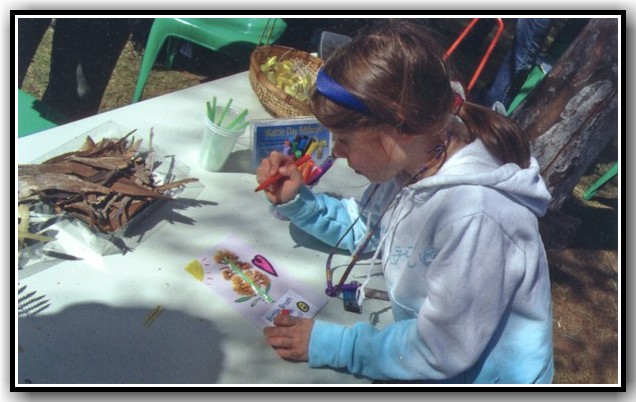November
and December
Generally speaking
most of your spring plantings should be complete by November to enable
as much establishment as possible by summer, although I am sure at times
it is a great temptation to continue planting into early summer. It
is often hard to go past a great native plant specimen when browsing
through your local nursery.
Ensure you are
prepared for part of the windy season in Canberra by following some
of the suggestions below.
Plant your plants
in the correct location according to their needs; you can move pots
into a more sheltered location out of the hot, windy weather.
Mulch garden beds
and pots to reduce evaporation from the soil, preferably with renewable
wood chip or leaf matter from your garden. I have found gravel mulches
work well particularly in locations where wind and water actually dislodge
organic mulches, even in pots. Planting ground covers will also resist
wind and water erosion. Some species include : Grevillea 'Bronze
Rambler', G. x gaudichaudii, G. 'Poorinda Royal
Mantle', G. juniperina 'Molonglo', G australis (prostrate
form), Hardenbergia violacea (climber or ground cover), Myoporum
parvifolium, Chrysocephalum apiculatum, just to name a few of the
more reliable species. You can even consider clumping native grass species
together to achieve similar results.
You should be able
to prune many of your spring flowering native plants after they have
flowered. Pruning will result in more compact plants and encourage more
profuse floral displays. There are a vast number of native plants that
will benefit from pruning, including : Prostanthera, Crowea, Correa,
Boronia, Calistemon, Melaleuca, Telopea and Grevillea species.
Evaluate your watering
schedule, which will be either automatic or manual, and adjust it accordingly.
It is crucial not to just water according only to your past practices,
but to get down in the dirt and check if it is actually dry. If you
have followed advice for mulching, planting ground covers, etc, you
may find that the soil is still moist. It is obviously important to
abide by current water restrictions.
If you are going
away, prepare your garden for the Christmas break, ask neighbours or
friends to at least keep the water up to your plants or check on the
automatic system and ensure it is working. You can install temporary
or permanent irrigation systems on your pots by installing irrigation
controllers that operate on batteries.
Much of the above
is relevant for us in the ANBG, but obviously on a much larger scale.
We have many different species to maintain in various situations and
microclimates, and we also have to plan for the Christmas break as it
is a crucial part of the year. We mainly focus on watering, safety and
emergency issues.
It is always important
to keep on top of weed removal as November is on the tail end of one
of the two peak growing seasons in Canberra.
January
and February
The main focus
during this time of the year is to keep the water up to your plants;
this is also the main focus at the ANBG.
If you have time,
continue with other tasks, such as pruning, weeding and pest control.
If you are considering
applying wetting agents, just be aware that repeat applications may
be needed over a period of time, depending on which type you are using.
As a response to the drought and water restrictions there are now many
different products on the market, and it is always advisable to follow
the label instructions.
Start planning
for autumn; consider planting requirements for your garden, as the best
time to plant in Canberra is generally during autumn.
March
Start planting
early, including trees, shrubs, grasses etc, and then plants will have
up to nine months to 'settle in' prior to their first summer.
If you need to
prune your native grasses, autumn would be a reasonable time to carry
out this task, but be careful not to cut shorter than approximately
150 mm. Other ways include combing or burning, although I would suggest
you seek advice about burning off in the A.C.T.
If you feel you
need to fertilise your native plants, early autumn is generally a good
time to do this. If your garden is basically self-sustaining utilising
leaf litter, compost and prunings, there should be little need to apply
fertilisers. Pot plants are the exception as nutrients are leached quickly
due to the free-draining media.
Obviously your
native plants will benefit from extra nutrients and each garden will
have varying requirements dependent on numerous factors, including soil,
aspect, microclimate, plant species, moisture etc.
Pots are a great
way to grow some of the more difficult to cultivate native plants. Some
Lechenaultia species perform well in pots, flowering from the
end of winter through spring and summer. They are a good substitute
for exotic annuals and bulbs as the plants will survive for a number
of years. There are many other native plants that perform better in
pots than in-ground situations.
There are many
pests and diseases to cope with in the garden during the November to
March period. It is not always necessary to control all pests as doing
so could upset the balance of the beneficial organisms. As for the ANBG,
there are acceptable levels of pests and disease damage to plants in
your native garden. One of the most important issues with pests and
disease attack to plants is to keep your plants in a healthy condition,
but it is bet to avoid over-fertilising and promoting excessive growth.
Many of the pests
and diseases found in a native garden and other gardens that you may
be familiar with are listed below. They can affect plants in a multitude
of situations there there are numerous ways of controlling or containing
a large number of them :
scale,
aphids, scarab grubs, lace bug, mites, caterpillars, weevils, borers,
beetles, snails, slugs, earwigs, fungus, bacteria, animals, other microscopic
organisms.
*
* * * *


